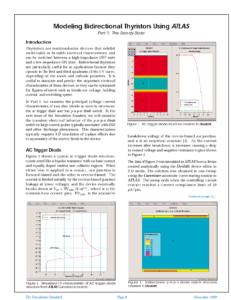Modeling Bidirectional Thyristors Using ATLAS
Introduction
Thyristors are semiconductor devices that exhibit multi-stable or bi-stable electrical characteristics, and can be switched between a high-impedance OFF state and a low-impedance ON state. Bidirectional thyristors are particularly useful for ac applications because they operate in the first and third quadrants of the I-V curve, depending on the anode and cathode polarities. It is useful to simulate and predict the important electrical characteristics of these devices, so they can be optimized for figures-of-merit such as breakover voltage, holding current, and switching speed.
In Part 1, we examine the principal voltage-current characteristics of two diac (diode ac switch) structures: the ac trigger diode and the p-n-p-n diode switch. In the next issue of the Simulation Standard, we will examine the transient electrical behavior of the p-n-p-n diode switch for large current pulses typically associated with ESD and other discharge phenomena. This characterization typically requires 3-D simulation of z-plane effects due to asymmetry of the electric fields in the device.



